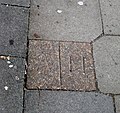Schanzenstrasse
The Schanzenstraße is a street in the Hamburg district of Sternschanze . It got its name after the formerly neighboring defense system Sternschanze . Today it is a central street of the so-called Schanzenviertel .
Location and history
The Schanzenstraße runs from north to south in a slight curve between the intersection of Altonaer Straße / Weidenallee / Kleiner Schäferkamp and the new horse market . In the past only the northern third of today's Schanzenstrasse bore this name; the southern part was called "Neue Rosenstrasse" from 1841 to around 1900. Today's numbering of houses begins with number 1 in the south and ends with number 125 in the north.
With the construction of the Hamburg-Altona connection line , Schanzenstrasse and Neue Rosenstrasse were moved approx. 100 meters to the west in 1885. This was probably due to the expansion of the freight track systems at Sternschanze station .
At the southern end of the street, today at the level of the house numbers Schanzenstrasse 1 to 7, ran a short stretch of the border between the city of Hamburg and the then still independent city of Altona . The historical boundary markings with the letters [A | H] for Altona and Hamburg are still there in the pavement today. At the height of today's house number 7, the border bent to the northwest to the shoulder blade , separating the so-called “Hamburger Hof” between the two streets.
Montblanc House
use
The urban redevelopment, which had already begun in the “Neue Rosenstrasse” and continued well into the 20th century, led to a heterogeneous mix of residential developments and commercial operations in very different buildings. This originally also included Hagenbeck's Tierpark with a location on Ludwigstrasse, which flows into the east, with the gateway to "Hagenbeck's Thierpark" being the gateway to the Augustenpassage, right next to Hagenbeck's residential and office building, Neuer Pferdemarkt 13.
Many commercial enterprises had a connection to the nearby Hamburg slaughterhouse . Since 1867 there was a "compulsion for the butchers in the inner city to only slaughter in the public slaughterhouse". However, this constraint has often been circumvented.
In 1903 the Sternschanze station was relocated to Schanzenstrasse. Today it is a heavily frequented stop on the Hamburg S-Bahn . Until around 1970, long-distance trains also stopped here at their own platform, which is now closed and largely dismantled. In 2008, a new building of the Hamburg branch of the Federal Railway Authority went into operation next to the train station .
The Montblanc stationery factory has had its headquarters in Hamburg since 1908 . The company's factory and administration building was at Schanzenstrasse 75 until 1989. The Montblanc house with its striking brick facade and wood-paved courtyard is now a listed building and has been used by the Hamburg Adult Education Center since 1991 .
Individual evidence
- ↑ Horst Beckershaus: The Hamburg street names. Where do they come from and what they mean. (Hamburg: Kabel-Verlag / Hamburger Abendblatt, 1997), quoted from www.20359hamburg.de/strassenverzeichnis
-
^ Reinhold Pabel : Old Hamburg Street Names , Edition Temmen, Bremen 2001 and
Schnitger: Hamburg Street Names. In: Hamburger Schulzeitung, vol. 6, p. 295, quoted from 20359hamburg.de/strassenverzeichnis - ↑ Compare with the map of Hamburg 1888 , map of Hamburg and Altona 1890 and map of Hamburg and Altona 1910
- ↑ 20359hamburg.de/strassenverzeichnis under "Viehhof"
- ^ Michael Gretzschel, Klaus Gille Michael Zapf: Hagenbeck - Ein zoologisches Paradies , Edition Temmen 2007, pp. 23–24, ISBN 978-3-86108-873-8
- ^ C. Boysen: Hamburg's slaughterhouse and cattle market facilities. Ed. On behalf of the slaughterhouse deputation by C. Boysen, director (Hamburg, 1897), p. 4, quoted from 20359hamburg.de/strassenverzeichnis



